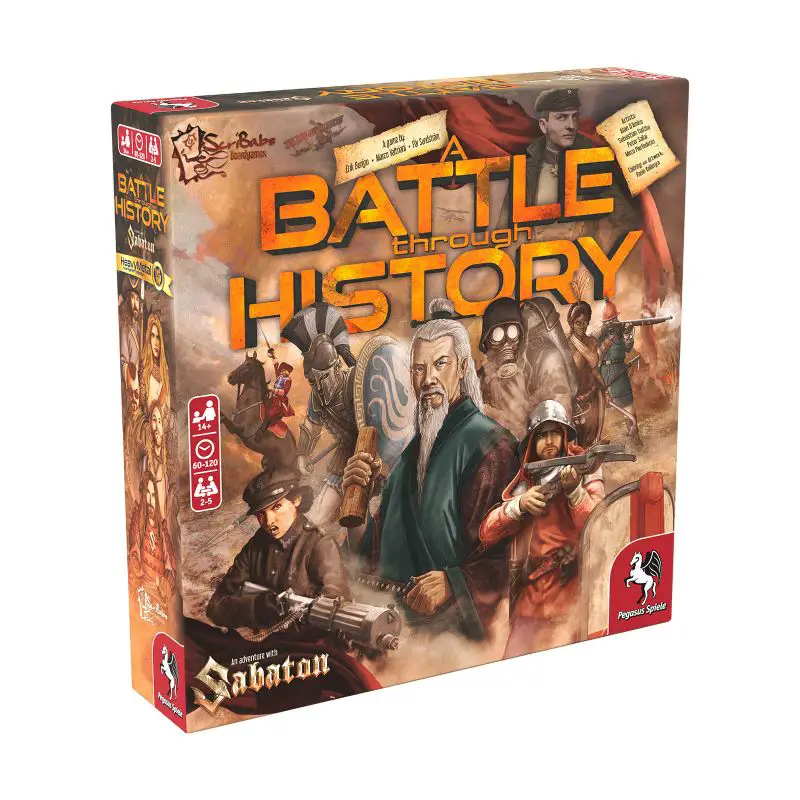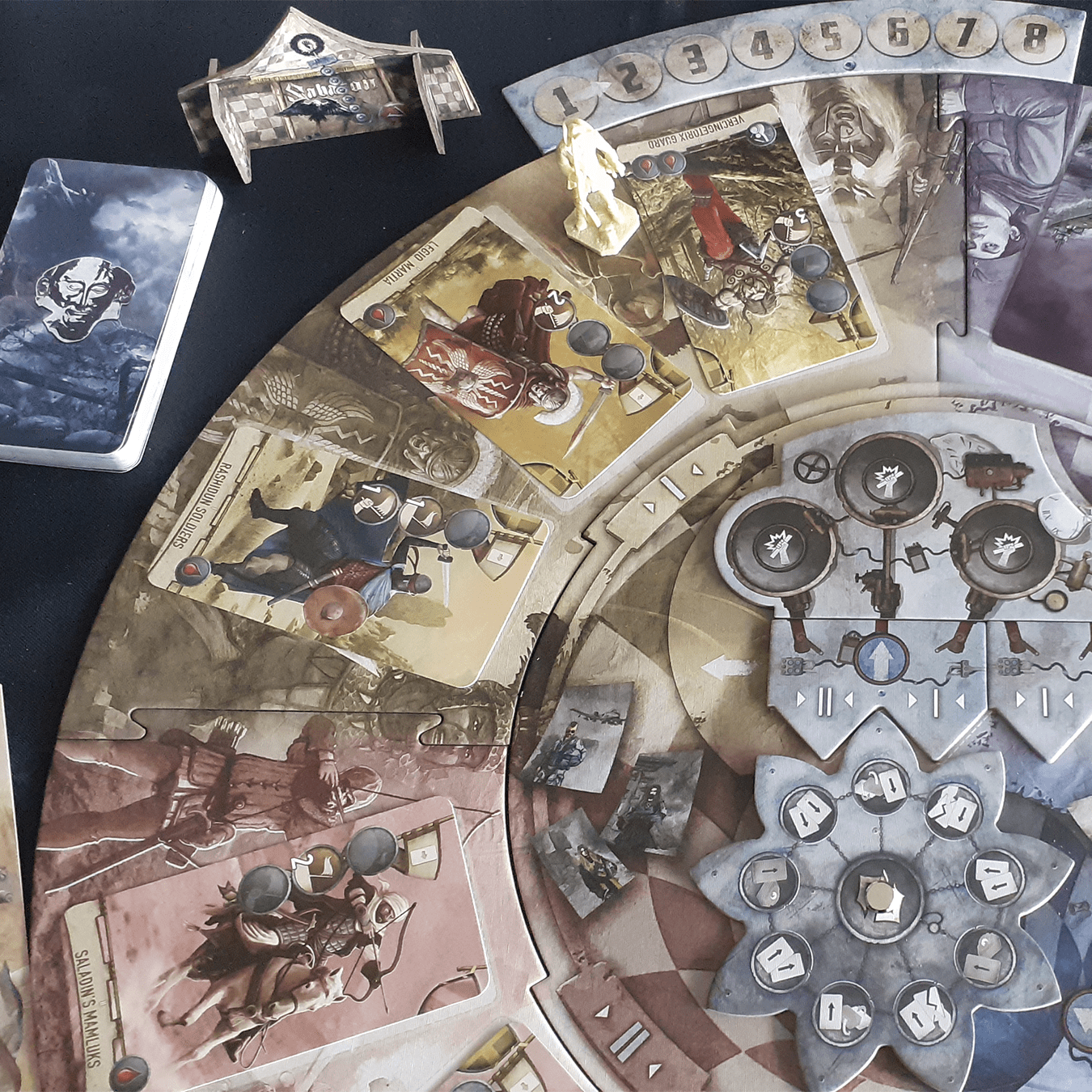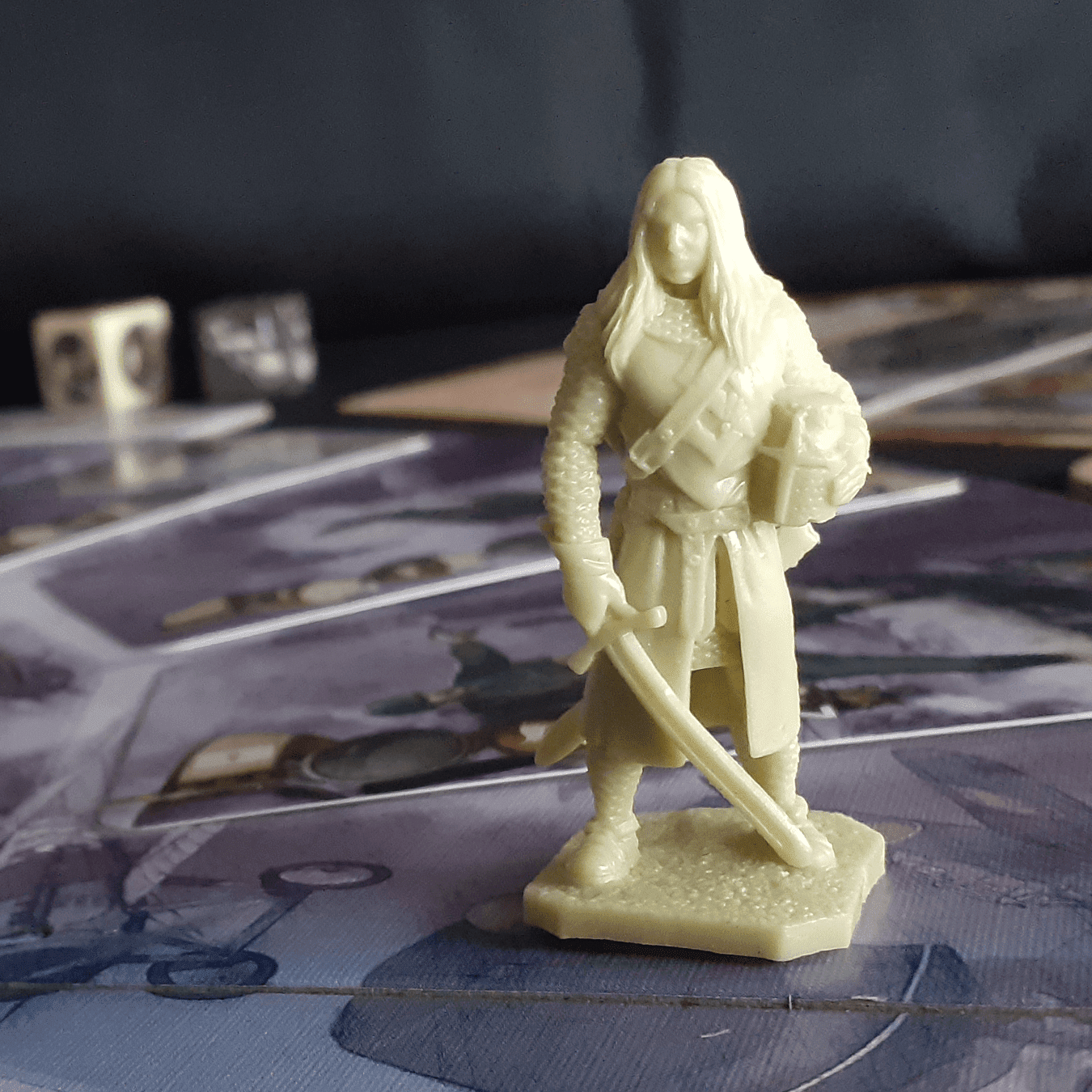Welcome back friends. We return once more to the wonderful world of tabletop gaming, with a game that’s a bit more complex than the last one. Just a smidge.
Today we’ll be taking a look at A Battle Through History, a journey through space and time where you get to play a time-traveling storyteller (a “Sabaton”) who will relive epic and unlikely battles side by side with legendary troops and heroes. Whoever can collect the greatest Units, Heroes, and Relics wins the game.

As you may have guessed from the title for a time-travelling storyteller, A Battle Through History is an officially licensed game for the Swedish metal band Sabaton, published by German company Pegasus Spiele (Fyfe, Carnegie). This isn’t Pegsus Spiele’s only licensed heavy metal board game, they also released Armata Strigoi with the band Powerwolf.
I never listened to Sabaton before this review, so I can’t really tell you if knowledge of the band especially helps you enjoy this game or not. I certainly don’t feel as though I enjoyed it less for the lack of knowing, but I can’t tell you if I would have enjoyed it more either.
The Shape Of The Battle
:strip_icc()/pic6477360.jpg)
A Battle Through History is a game about war, but it is not a war game. The emphasis is less on the mechanics and realities of war and more about the legends and stories of war. To be declared a “Sabaton” in this game is not to be a general or a hero but to be a storyteller. According to the official Sabaton website, the game was inspired by the band’s love of history and stories (as well as their love of board and role playing games). With an editor’s note in every version of the instructions (there’s multiple copies in multiple languages) decrying violence and war while honoring those who gave their lives, this is very clear.
So, if it’s not a war game, how does A Battle Through History work?
To start, you pick a member of the band you wish to play as. There’s no getting around this being a Sabaton game, fair warning. Wasn’t a problem for me, but I can’t speak for everyone, obviously.
:strip_icc()/pic6462954.jpg)
Regardless, once you’ve picked your ‘character’, you’ll assemble the round board known as the Gears of History, then separate the cards, tokens, and tiles as directed by the instructions. Every unit card belongs to a different deck (base units are divided by the specific Sabaton member they correlate to, while elite units are divided by historical era, with symbols on the cards to highlight who goes where) so be sure to organize them properly.
:strip_icc()/pic6477396.jpg)
Once this has been done, you will draw the tokens and cards you need to begin play. The game can last from six to eight rounds, depending on your preferences, and you choose who goes first.
Each turn will begin with the player choosing which era they wish to place their traveler on, either in order to collect one of the elite units face up in that era or to do battle with another traveler. Regardless of which route you take, all combat in A Battle Through History is determined by the unit cards you’re able to field and the roll of the dice. The game even goes so far as to have different dice available depending on how strong your position on the battlefield is. Battles are done to recruit elite units and to add relics to your pile.

This goes on for all the players, though no more than two can be in an era at once, until you return to the original player. They go again, starting a new round, and you’ll continue until you’ve hit the final round (usually six, but you can go to eight if you desire). Once there, you’ll tally points. There are special tokens you can collect to boost your points, but the majority will come from the Elite Unit, Hero, and Relic cards you’ve collected.
The point values of Relic cards are increased in correlation with their Era (the more Relics you have from a specific era, the more they’re worth) but that’s only true for Relics. Elite Units and Heroes don’t benefit from the other such cards you have. The winner is whoever has the highest point total (in the case of a tie, whoever has the most Relics wins).

Final Thoughts
A Battle Through History is, above all else, a complex strategy game. This is not something to pick up casually because you like Sabaton or history or both. The board is too complex and the card art not unique enough to make it a display item.
That’s not to say that it’s a bad game. Far from it. It’s a very solid game all around. However, I would be remiss in not emphasizing the point that it is a complex game of strategy. Looking at the instruction manual and all the pieces required for set-up nearly gave me a headache the first time.

The bright side of this all is that A Battle Through History accommodates a variety of strategies, whether you want to play it safe or play things aggressively. There is a degree of chance worked in, as the game relies on multiple decks of cards and on dice, but these are flair to the overall game, not the be all end all. You can’t go in expecting wing it and win.
I’m not a Sabaton fan, so I can’t weigh in on if being one will increase the overall value of the game beyond the general benefits of owning official merch for a band you love. But, if you like history, strategy games, or figures from across history meeting and clashing, than this might very well be a game for you. I certainly don’t regret having played it, even if I don’t know how often I’ll return to it.
You can pick up A Battle Through History on the Target site, Sabaton’s site, or your FLGS, at an MSRP of $50.
Images Courtesy of ScriBabs and Pegasus Spiele. Thank you to Pegasus Spiele for the copy of the game used in this review.
Have strong thoughts about this piece you need to share? Or maybe there’s something else on your mind you’re wanting to talk about with fellow Fandomentals? Head on over to our Community server to join in the conversation!

